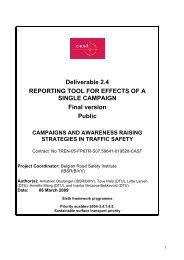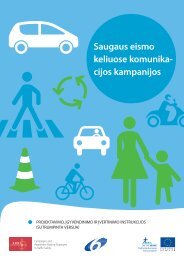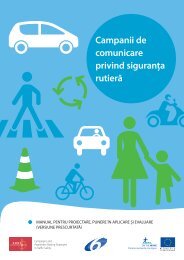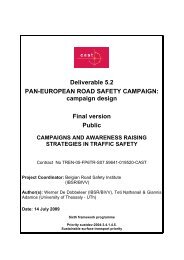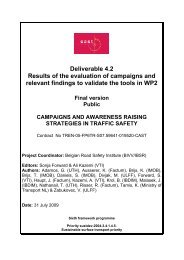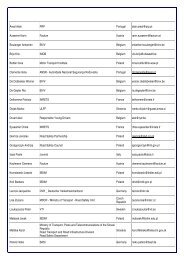Deliverable D 1.3 RESULTS OF META-ANALYSIS ... - cast-eu.org
Deliverable D 1.3 RESULTS OF META-ANALYSIS ... - cast-eu.org
Deliverable D 1.3 RESULTS OF META-ANALYSIS ... - cast-eu.org
Create successful ePaper yourself
Turn your PDF publications into a flip-book with our unique Google optimized e-Paper software.
Campaigns and awareness raising strategies in traffic safety — <strong>Deliverable</strong> D <strong>1.3</strong>Because they are more representative of the real world situation, the conclusionsdrawn below are based mainly on the results from multivariate analysis.Campaigns achieving intimacy and immediacy could be more effectiveBoth bivariate and multivariate analyses suggest that campaigns using some form ofpersonal communication with the target audience have somewhat improved effects,both on accidents and behaviour (seatbelt use). The variable personalcommunication, according to our definition, encompassed the use of lesson,seminars or other sessions delivered in person, two-way or group discussions with apeer, teacher, safety expert or deliverer of campaign media, or personally addressedletters. The use of a personal element or the use of other people as channels for thedelivery of the campaign message implies that an increased level of intimacy withthe target could be important, possibly because it increases the likelihood that thetarget attends and processes the campaign message (Vaa et al., 2004; also seeWork Package <strong>Deliverable</strong> 1.4).According to multivariate models, on-road delivery is also positively associated withcampaign effects, on both accidents and seatbelt use. On-road delivery involves th<strong>eu</strong>se of billboards, or other fixed or variable message signs placed at the side of theroad. This suggests that delivery of the message to drivers at a place that is in termsof space and time proximal to the target behaviour is beneficial in terms of campaigneffect. In other words, achieving immediacy in the delivery of a campaign messagemight be important.In terms of accident counts, short campaign duration is also beneficial according tomultivariate analyses, and this also implies a sense of immediacy. In shorter, moreintense campaigns, the message may be more likely to be received at a time that isproximal to carrying out of the target behaviour.Taken together, intimacy and immediacy suggest that those campaigns that makethe target person think carefully about the message in the context of the drivingbehaviour would tend to be more successful at achieving effects during or after thecampaign. In this light, it is interesting to consider that the carrying out of campaignsin a limited area, such as an <strong>org</strong>anisation or car park, was positively associated withimprovements in seatbelt use, since such campaigns would presumably be morelikely to use personal communication and deliver the message to the driver at a timethat is proximal in space and time to the context of the targeted driving behaviour.But mass media methods are still importantLack of evidence linking mass-media methods such as television or radio toimprovements in campaign effects (whether accident counts or seatbelt use is theoutcome measured) is in line with the idea that intimacy and immediacy arebeneficial to campaign outcomes. To this we can add those findings from bivariateanalysis that selection for campaigns using mass-media results in either the same orreduced overall effects, across several behavioural outcome measures. While wecannot conclude from bivariate analyses that use of mass-media has less effect atthe local level, than at regional or national levels, it does seem that within a smallarea, where a much more focused campaign is possible, those methods which are7



